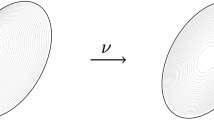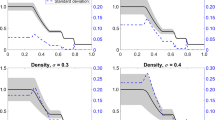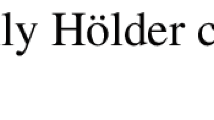Abstract
A linearly implicit (Rosenbrock-type) numerical method for the integration of three-dimensional Navier–Stokes equations for compressible fluid with respect to time is proposed. The method has four stages and third order of accuracy with respect to time. As the benchmark, the Cauchy problem on a 3D torus is solved. The computed distributions are compared with the solution specified by the ABC flow.
Similar content being viewed by others
REFERENCES
H. H. Rosenbrock, “Some general implicit processes for the numerical solutions of differential equations,” Comput. J. 5, 329–330 (1962).
T. Steihaug and A. Wolfbrandt, “An attempt to avoid exact Jacobian and nonlinear equations in the numerical solution of stiff differential equations,” Math. Comp. 33 (146), 521–534 (1979).
X. Liu, Y. Xia, H. Luo, and L. Xuan, “A comparative study of Rosenbrock-type and implicit Runge–Kutta time integration for discontinuous Galerkin method for unsteady 3D compressible Navier–Stokes equations,” Commun. Comput. Phys. 20, 1016–1044 (2016).
F. Bassi, L. Botti, A. Colombo, A. Ghidoni, and F. Massa, “Linearly implicit Rosenbrock-type Runge–Kutta schemes applied to the discontinuous Galerkin solution of compressible and incompressible unsteady flows,” Comput. Fluids 118, 305–320 (2015).
L. Wang and M. Yuy, “A comparative study of implicit Jacobian-free Rosenbrock–Wanner, ESDIRK and BDF methods for unsteady flow simulation with high-order flux reconstruction formulations,” AIAA Aerospace Sciences Meeting, 2018, p. 1095.
D. S. Blom, P. Birken, H. Bijl, F. Kessels, A. Meister, and A. H. van Zuijlen, “A comparison of Rosenbrock and ESDIRK methods combined with iterative solvers for unsteady compressible flows,” Adv. Comput. Math. 42, 1401–1426 (2016).
J. Rang and L. Angermann, “New Rosenbrock W-methods of order 3 for partial differential algebraic equations of index 1,” BIT Num. Math. 45, 761–787 (2005).
E. Hairer, S. Nørsett, and G. Wanner, Solving Ordinary Differential Equations, Vol. 2: Stiff and Differential-Algebraic Problems (Springer, Berlin, 1987–1991).
T. J. Coakley, “Implicit upwind method for the compressible Navier–Stokes equations,” AIAA J. 23, 374–380 (1985).
S. K. Godunov, “A difference method for numerical calculation of discontinuous solutions of fluid dynamics equations,” Mat. Sb. 47 (3), 271–306 (1959).
V. G. Krupa, “Direct simulation of the turbulent boundary layer on a plate,” Comput. Math. Math. Phys. 56, 1488–1505 (2016).
A. A. Samarskii and E. S. Nikolaev, Numerical Methods for Grid Equations (Nauka, Moscow, 1978; Birkhäuser, Basel, 1989).
S. Friedlander, A. D. Gilbert, and M. Vishik, “Hydrodynamic instability for certain ABC flows,” Geophys. Astrophys. Fluid Dynam. 73, 97–107 (1993).
Author information
Authors and Affiliations
Corresponding author
Additional information
Translated by A. Klimontovich
Rights and permissions
About this article
Cite this article
Krupa, V.G. A Numerical Third-Order Method for Solving the Navier–Stokes Equations with Respect to Time. Comput. Math. and Math. Phys. 59, 1881–1892 (2019). https://doi.org/10.1134/S0965542519110083
Received:
Revised:
Accepted:
Published:
Issue Date:
DOI: https://doi.org/10.1134/S0965542519110083




